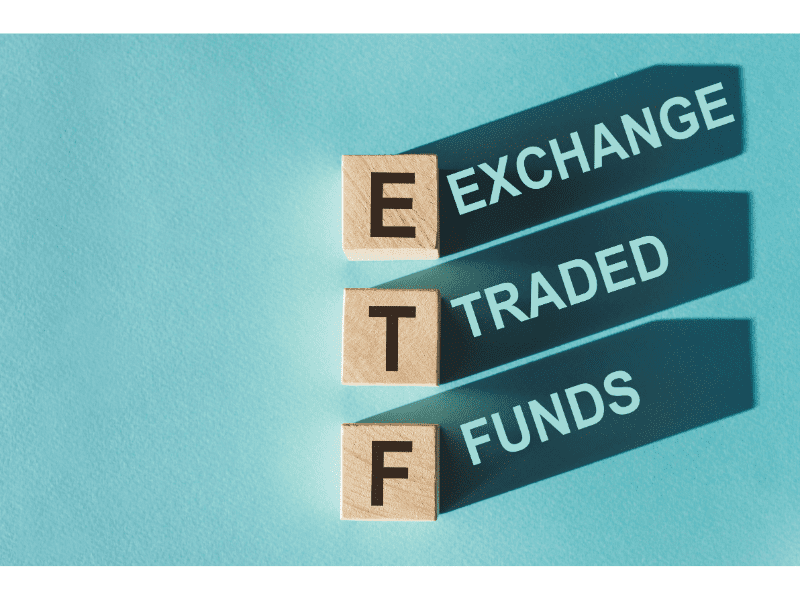In the dynamic world of investment, Exchange-Traded Funds (ETFs) and Real Mutual Funds stand out as two popular options, each with its own set of characteristics. Understanding the nuances between them is crucial for investors seeking the right fit for their financial goals. ETFs and Real Mutual Funds share common ground but diverge in critical aspects, including structure, expenses, and tax implications.
This article aims to shed light on the comparative analysis of ETFs and Real Mutual Funds, helping investors make informed decisions aligned with their investment objectives.
Table of Contents
Definitions of ETFs and Real Mutual Funds
Definition of ETFs
Exchange-traded funds (ETFs) are investment funds that trade on stock exchanges, similar to individual stocks. These funds pool money from various investors to purchase a diversified portfolio of stocks, bonds, or other assets. ETFs offer investors exposure to a broad range of assets, allowing them to diversify their portfolios without having to buy each security individually.

One of the key features that distinguishes ETFs is their tradability throughout the trading day, providing investors with flexibility in buying and selling shares at market prices. ETFs have gained popularity for their low expense ratios and tax efficiency, making them a versatile and accessible investment option for both beginners and experienced investors.
Understanding the structure and benefits of ETFs is essential for making informed investment decisions in today’s dynamic financial markets.
Definition of Real Mutual Funds
Real Mutual Funds, also known as traditional mutual funds, are investment vehicles that pool money from multiple investors to create a diversified portfolio of stocks, bonds, or other securities. Unlike exchange-traded funds (ETFs), real mutual funds are not traded on stock exchanges throughout the day; instead, they are bought and sold at the end of the trading day at the net asset value (NAV) price.

These funds are actively managed by professional fund managers who make investment decisions based on the fund’s objectives. Real mutual funds offer investors the opportunity to benefit from active management strategies, potentially outperforming the market.
However, they may have higher expense ratios compared to ETFs due to the active management involved. Real mutual funds are well-suited for investors seeking professional management and a more hands-off approach to their investment portfolios.
Understanding the structure and characteristics of real mutual funds is crucial for investors looking to diversify their holdings and meet specific financial goals.
Importance of choosing the right investment option
Selecting the appropriate investment option is a critical decision that significantly impacts an investor’s financial success and overall portfolio performance. The choice between ETFs and real mutual funds is one such decision, and it holds considerable importance.
The selected investment option should align with the investor’s financial goals, risk tolerance, and investment strategy. Each option comes with its own set of advantages and disadvantages, and understanding these factors is crucial for making informed decisions.
A well-suited investment option can provide the desired level of diversification, potentially higher returns, and effective risk management. Additionally, the right investment choice can contribute to achieving long-term financial objectives, such as retirement planning or wealth accumulation.
Therefore, investors should carefully assess their individual preferences and needs before deciding between ETFs and real mutual funds to ensure their investment aligns with their financial goals and expectations.
Comparison Table of ETFs and Real Mutual Funds
Comparison table highlighting key differences between Exchange-Traded Funds (ETFs) and traditional Mutual Funds:
| Feature | ETFs | Mutual Funds |
|---|---|---|
| Structure | Traded on stock exchanges like stocks | Bought/sold through the fund company at NAV |
| Trading | Throughout the trading day | At the end of the trading day (after market close) |
| Minimum Investment | Can be bought in increments of one | Often have minimum investment requirements |
| Management Style | Passive (Index-tracking) or Active | Passive or Active management options |
| Expense Ratios | Generally lower | Can vary, may include sales loads and other fees |
| Flexibility | Intraday trading flexibility | Transactions at end-of-day only |
| Pricing | Market price may differ from NAV | Traded at NAV (Net Asset Value) |
| Tax Efficiency | Generally tax-efficient | May distribute capital gains to investors |
| Dividend Distribution | Reinvested or paid as cash | Options for reinvestment or cash distributions |
| Investor Base | Appeals to more active traders | Attracts a broader range of investors |
| Redemption Process | Can be sold in the market anytime | Redeemed through the fund company at end-of-day |
| Creation/Redemption | In-kind creation and redemption | In-kind or cash creation/redemption process |
This table provides a snapshot of the primary distinctions between ETFs and Mutual Funds, considering aspects such as structure, trading, expense ratios, and tax efficiency. It’s important to note that both investment vehicles have their merits, and the choice between them depends on individual investment goals, preferences, and strategies.
Advantages and Disadvantages of ETFs and Real Mutual Funds
Advantages of ETFs:
- Liquidity and Flexibility:
ETFs trade on stock exchanges throughout the day, providing investors with the flexibility to buy and sell shares at market prices. This liquidity allows for quick and efficient transactions. - Lower Expense Ratios:
ETFs often have lower expense ratios compared to actively managed funds. The passive management style, often tracking an index, contributes to reduced operating costs, benefitting investors with lower fees. - Easy Diversification:
ETFs offer instant diversification as they typically hold a basket of assets. Investors can gain exposure to a broad market, specific sectors, or even niche themes, facilitating a convenient way to diversify their portfolios.
Disadvantages of ETFs:
- Limited Access to Certain Markets or Sectors:
Some niche or less liquid markets may not be efficiently accessible through ETFs. Investors seeking exposure to specific industries or regions might find limitations in the available options. - Potentially Higher Trading Costs:
While ETFs generally have low expense ratios, investors may incur trading costs, especially if they frequently buy and sell shares. Frequent trading can lead to higher transaction fees and may erode potential cost savings. - Lack of Active Management:
Passive ETFs aim to replicate the performance of an index, meaning there is no active management to capitalize on market opportunities or adjust strategies based on changing market conditions. This lack of active decision-making can be a drawback for those who prefer a hands-on approach.
Understanding these advantages and disadvantages is crucial for investors to align their preferences and investment strategies with the characteristics of ETFs. It allows them to make informed decisions that suit their financial goals and risk tolerance.
Advantages of Real Mutual Funds:
- Professional Management and Active Investment Strategies:
Real Mutual Funds are actively managed by professional fund managers. This active approach involves continuous monitoring of market conditions, making strategic investment decisions, and adjusting the fund’s holdings to optimize performance. - Access to a Wide Range of Investments:
Mutual funds offer investors access to a diverse portfolio of assets. From stocks and bonds to various sectors and industries, real mutual funds provide a broad range of investment options that may not be readily available to individual investors. - Dividend Reinvestment Options:
Many mutual funds offer dividend reinvestment programs (DRIPs), allowing investors to automatically reinvest dividends back into the fund. This can enhance the power of compounding and potentially increase the overall return on investment over time.
Disadvantages of Real Mutual Funds:
- Potentially Higher Expense Ratios:
Actively managed mutual funds often incur higher expense ratios compared to passive ETFs. The costs associated with professional management, research, and trading within the fund can result in higher fees, impacting the overall returns for investors. - Lower Levels of Liquidity:
Mutual funds may have lower liquidity compared to ETFs. The process of buying or selling mutual fund shares involves end-of-day pricing, and redemptions can be subject to potential delays. This can limit the speed at which investors can access their funds. - Tax Implications for Actively Managed Funds:
Actively managed funds may experience higher turnover of securities, leading to potential capital gains distributions. This can have tax implications for investors, depending on their individual tax situations, and may result in additional tax liabilities.
Understanding the advantages and disadvantages of real mutual funds provides investors with valuable insights into the characteristics of these investment vehicles. This knowledge empowers individuals to make informed decisions aligned with their financial goals and risk tolerance.
Pros and Cons of ETFs vs. Real Mutual Funds
Pros of ETFs:
- Lower Costs and Fees:
ETFs are known for their cost efficiency. With generally lower expense ratios, investors in ETFs may benefit from reduced costs over the long term, enhancing overall returns. - Tradeability and Flexibility:
ETFs trade on stock exchanges like individual stocks, providing investors with the flexibility to buy and sell throughout market hours at market prices. This intraday tradability offers more control over entry and exit points. - Tax Efficiency:
ETFs often employ in-kind transactions, a tax-efficient mechanism that can minimize capital gains distributions. This tax structure may appeal to investors seeking to manage their tax liabilities.
Cons of ETFs:
- Limited Access to Niche Markets:
Some niche or less liquid markets may not have corresponding ETFs. Investors with specific interests in these areas might find their options limited within the ETF universe. - Potential Tracking Error:
While ETFs aim to track the performance of an underlying index, there can be slight discrepancies between the ETF’s performance and the index due to tracking error. This can impact returns for investors.
Pros of Real Mutual Funds:
- Active Management and Higher Potential for Alpha:
Real mutual funds, with active management, have the potential to outperform the market (generate alpha) through strategic investment decisions made by professional fund managers. - Access to a Wide Range of Investment Options:
Mutual funds offer diversification across various asset classes, including stocks, bonds, and other securities, providing investors with a broad spectrum of investment opportunities. - Dividend Reinvestment Options:
Many mutual funds allow investors to reinvest dividends automatically, contributing to the compounding of returns over time.
Cons of Real Mutual Funds:
- Higher Expenses and Fees:
Actively managed mutual funds typically have higher expense ratios compared to ETFs, potentially impacting the overall returns for investors. - Potential Tax Implications:
Actively managed funds may generate capital gains distributions, leading to potential tax implications for investors depending on their individual tax situations. - Lower Levels of Liquidity Compared to ETFs:
Mutual funds may have lower liquidity than ETFs, impacting the speed at which investors can buy or sell shares.
Understanding the pros and cons of both ETFs and real mutual funds is crucial for investors when deciding which investment option aligns best with their financial objectives and preferences. Careful consideration of these factors ensures that individuals can make well-informed investment decisions.
Encouragement for investors to carefully consider their investment goals and risk tolerance

Before embarking on your investment journey, it’s crucial to take a moment for thoughtful reflection. Consider your investment goals, both short-term and long-term, and assess your risk tolerance. Understanding your financial objectives and the level of risk you’re comfortable with is the cornerstone of making informed investment decisions.
Both Exchange-Traded Funds (ETFs) and Real Mutual Funds offer distinct advantages, but the choice between them should align with your individual preferences, financial ambitions, and risk appetite. If you’re drawn to the flexibility and lower costs associated with ETFs, ensure these attributes complement your investment strategy. On the other hand, if you appreciate active management and a broader array of investment options, real mutual funds might be your preference.
Remember, there’s no one-size-fits-all approach to investing. Every investor is unique, and your portfolio should reflect your personal financial narrative. Seek advice if needed, stay informed about market trends, and remain flexible in adapting your strategy as your financial circumstances evolve.
In the dynamic world of finance, where options abound and market conditions fluctuate, a carefully considered investment plan aligned with your goals is your compass. So, take the time to assess, plan, and invest with confidence, knowing that a well-thought-out strategy is the foundation for a potentially rewarding investment experience.
While the world of investing offers exciting possibilities, it also presents complexities that might be challenging to navigate alone. This is where the value of professional advice becomes evident. Seeking guidance from financial experts can provide you with a clearer understanding of the nuances in the market, potential risks, and strategies tailored to your unique financial situation.
A qualified financial advisor brings a wealth of knowledge and experience, helping you make informed decisions aligned with your goals and risk tolerance. They can offer insights into market trends, analyze your financial position, and recommend a diversified portfolio that suits your needs.
Investing involves a blend of strategic planning, risk management, and market understanding. A financial advisor serves as your partner in this journey, offering not only technical expertise but also a steady hand during market fluctuations. They can help you navigate uncertainties, stay disciplined in your investment approach, and make adjustments as needed.
Remember, professional advice is not just for experienced investors; it’s a valuable resource for beginners as well. Whether you’re exploring the potential of ETFs, Real Mutual Funds, or other investment options, having a trusted advisor by your side can make a significant difference in your financial success. So, before you embark on your investment journey, consider consulting with a professional to ensure you’re on the right path towards your financial goals.


2 thoughts on “ETFs or Real Mutual Funds – Which investment vehicle is right for you?”